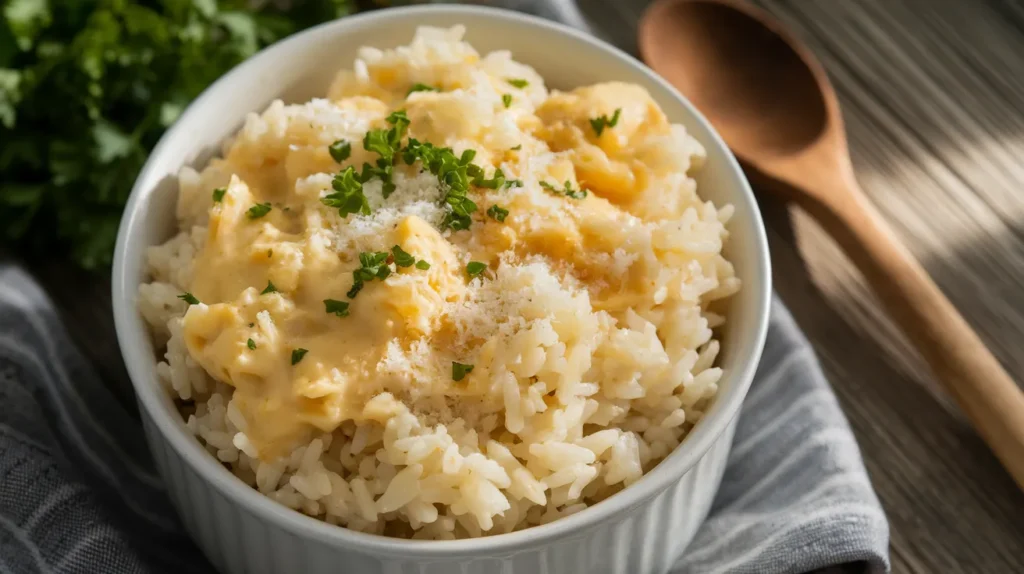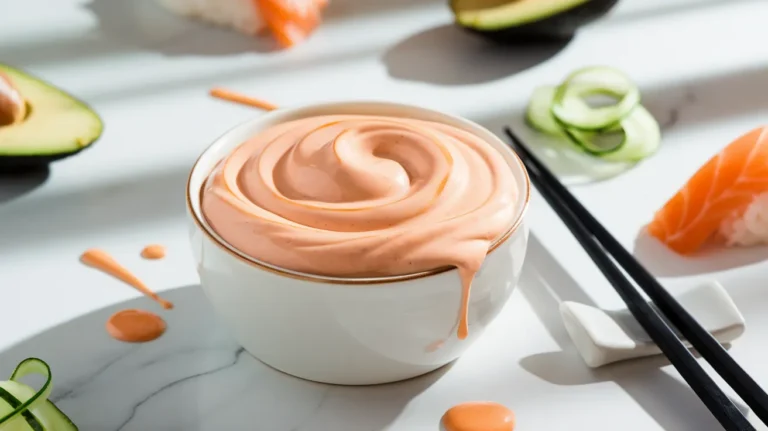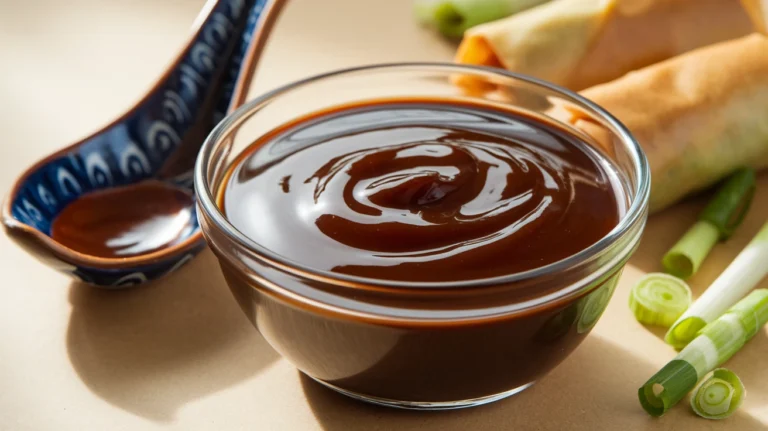Master these foolproof sauce for jasmine rice recipes that transform plain rice into restaurant-quality meals your family will request again and again. Each sauce for jasmine rice combination serves four people perfectly and uses simple ingredients you likely have in your pantry, making weeknight dinners both delicious and stress-free.
SERVES: 4 | PREP: 15 MIN | COOK: 15 MIN | TOTAL: 30 MIN
Ingredients by Category
Base Ingredients (For All Sauce for Jasmine Rice Recipes)
| Ingredient | Amount | Notes |
|---|---|---|
| Jasmine rice | 2 cups cooked | Day-old rice works best |
| Butter | 2 tbsp | Unsalted preferred |
| Garlic | 3 cloves | Minced fresh |
| Salt | 1/2 tsp | Adjust to taste |
Creamy Garlic Butter Sauce
| Ingredient | Amount | Purpose |
|---|---|---|
| Heavy cream | 1/2 cup | Creates richness |
| Parmesan cheese | 1/3 cup grated | Adds umami depth |
| Fresh parsley | 2 tbsp chopped | Color and freshness |
| Black pepper | 1/4 tsp | Enhances flavor |
Coconut Curry Sauce
| Ingredient | Amount | Purpose |
|---|---|---|
| Coconut milk | 3/4 cup | Creamy base |
| Curry powder | 1 tbsp | Main flavor profile |
| Ginger | 1 tsp grated | Aromatic warmth |
| Lime juice | 2 tbsp | Bright acidity |
Detailed Step-by-Step Instructions for Perfect Sauce for Jasmine Rice
Phase 1: Preparing Your Rice Foundation (8-10 minutes)
Step 1: Check Your Rice Quality Before starting any sauce for jasmine rice, examine your cooked rice. The grains should be separate and not clumped together. If using freshly cooked rice, spread it on a large plate and let it cool for 10 minutes. Day-old refrigerated rice works even better because the grains have had time to firm up and won’t become mushy when mixed with sauce.
Step 2: Heat Your Pan Properly Place a large 12-inch non-stick skillet or heavy-bottomed pan on your stove. Turn the heat to medium – this is crucial because high heat will burn your garlic later. Let the empty pan heat for 2 minutes. You’ll know it’s ready when you can hold your hand 6 inches above the surface and feel gentle warmth.
Step 3: Warm the Rice Gently Add your 2 cups of cooked jasmine rice to the heated pan. Using a wooden spoon or silicone spatula, gently stir the rice for 3-4 minutes. The rice should start to steam slightly and feel warm throughout. This step prevents cold rice from cooling down your sauce later. If any grains stick to the pan, reduce your heat to medium-low.
Step 4: Create Sauce Wells Push the warmed rice to one side of your pan, creating an empty space about 4 inches wide. This empty space is where you’ll build your sauce for jasmine rice without disturbing the rice. Think of it as creating a separate cooking zone within the same pan.
Phase 2: Building Your Sauce Base (5-7 minutes)
Step 5: Melt Butter to Perfect Temperature Add 2 tablespoons of butter to the empty space in your pan. Watch the butter carefully – it should melt gently and start to foam slightly. If the butter turns brown or makes crackling sounds, your heat is too high. Reduce to medium-low immediately. The butter is ready when it’s completely melted and has small, gentle bubbles around the edges.
Step 6: Add Garlic with Precision Drop your 3 minced garlic cloves directly into the melted butter. You should hear a gentle sizzling sound – not aggressive popping or crackling. Stir the garlic constantly with a small spoon for exactly 30-45 seconds. The garlic should become fragrant and turn very light golden. If it starts browning quickly, remove the pan from heat for 30 seconds to cool down.
Step 7: Season the Base Sprinkle 1/2 teaspoon of salt over the garlic butter mixture. Stir it in completely. Now, gently fold the seasoned garlic butter into your rice using a folding motion rather than stirring. Lift sections of rice and fold them over the butter, ensuring every grain gets coated. This creates the foundation that makes any sauce for jasmine rice taste professional.
Phase 3: Creating Your Chosen Sauce (8-12 minutes)
For Creamy Garlic Butter Sauce for Jasmine Rice:
Step 8: Add Cream with Care Pour 1/2 cup of heavy cream slowly into the pan, letting it pool in the center before stirring. The cream should integrate with the garlic butter without any separation. If you see the cream looking curdled or lumpy, your heat is too high. Reduce heat to low and whisk gently until smooth.
Step 9: Achieve Perfect Simmer Bring the cream mixture to a very gentle simmer. You should see tiny bubbles forming around the edges of the pan, but never large, rolling bubbles in the center. This gentle simmer will take 2-3 minutes. If large bubbles appear, reduce heat immediately – boiling cream can separate and become grainy.
Step 10: Add Cheese Gradually Remove the pan from heat before adding cheese. Sprinkle the 1/3 cup grated Parmesan cheese over the cream in three separate additions, stirring completely after each addition. The residual heat will melt the cheese smoothly. If you add all the cheese at once, it may clump.
Step 11: Finish with Fresh Elements Return the pan to low heat for 1 minute. Add 2 tablespoons of chopped fresh parsley and 1/4 teaspoon black pepper. Stir gently to distribute. The parsley should stay bright green – if it wilts immediately, your heat is too high.
For Coconut Curry Sauce for Jasmine Rice:
Step 8: Toast Spices for Maximum Flavor Add 1 tablespoon of curry powder directly to the garlic butter mixture. Stir constantly for 45 seconds. The curry powder should become very fragrant and slightly darker in color. This toasting step intensifies the flavor dramatically – skipping it results in flat-tasting sauce.
Step 9: Add Coconut Milk Slowly Pour 3/4 cup of coconut milk into the pan gradually, stirring constantly as you pour. Start with just 1/4 cup, stir until combined, then add the remaining coconut milk in two more additions. This prevents the coconut milk from separating or creating lumps in your sauce for jasmine rice.
Step 10: Incorporate Fresh Aromatics Add 1 teaspoon of freshly grated ginger to the sauce. Stir it in and let the mixture simmer gently for 2-3 minutes. The ginger should distribute evenly throughout the sauce. If using ground ginger instead of fresh, use only 1/2 teaspoon as it’s more concentrated.
Step 11: Balance with Acidity Remove the pan from heat and stir in 2 tablespoons of fresh lime juice. The lime juice brightens all the other flavors and prevents the sauce from tasting heavy. Taste the sauce now – it should have a balance of creamy, spicy, and tangy flavors.
Phase 4: Final Integration and Serving (3-5 minutes)
Step 12: Combine Rice and Sauce Properly Using a large fork or wooden spoon, gently fold the rice into your finished sauce. Use a lifting and folding motion rather than stirring, which can break the rice grains. Each grain should be lightly coated with sauce but not swimming in it. The rice should maintain its individual grain structure.
Step 13: Adjust Consistency If your sauce for jasmine rice appears too thick, add 1-2 tablespoons of warm chicken broth or water. If it’s too thin, continue cooking on low heat for 1-2 minutes to reduce slightly. The perfect consistency coats each grain without pooling liquid at the bottom of the pan.
Step 14: Final Seasoning Check Taste your finished dish and adjust seasoning. You might need an additional pinch of salt, a squeeze of lime juice, or a crack of black pepper. Professional chefs always taste and adjust at the end – this step separates good cooks from great ones.
Step 15: Serve Immediately Transfer your sauce for jasmine rice to serving bowls while still warm. The dish tastes best when served immediately, as the flavors are at their peak and the texture is perfect. Garnish with additional fresh herbs if desired.
Professional Chef’s Notes for Sauce for Jasmine Rice
• Rice Temperature Secret: Cold, day-old jasmine rice absorbs sauce better and maintains perfect texture. Fresh rice becomes mushy when mixed with hot sauce for jasmine rice.
• Heat Control Mastery: Medium to medium-low heat prevents burning and ensures smooth sauce consistency. High heat causes separation in cream-based sauces and burns garlic instantly.
• Ingredient Quality Impact: Use full-fat coconut milk and heavy cream for richest results. Low-fat versions create thin, watery sauce for jasmine rice that lacks body.
• Fresh vs. Dried Herbs: Add fresh herbs during the last 30 seconds of cooking to maintain vibrant color and intense flavor in your sauce for jasmine rice.
Nutrition Information (Per Serving)
- Calories: 285
- Protein: 8g
- Carbohydrates: 42g
- Fat: 12g
- Fiber: 1g
- Sodium: 320mg
Creative Sauce for Jasmine Rice Variations
Thai-Inspired Peanut Sauce
Create an exotic sauce for jasmine rice by whisking together 3 tablespoons creamy peanut butter, 2 tablespoons low-sodium soy sauce, 1 tablespoon rice vinegar, 1 teaspoon sriracha, and 1 teaspoon honey. Heat gently while stirring until smooth and glossy.
Mediterranean Lemon Herb Sauce
Build a bright sauce for jasmine rice using 1/4 cup extra-virgin olive oil, zest and juice of 2 lemons, 2 tablespoons fresh oregano, 1 tablespoon fresh thyme, and 1/4 cup crumbled feta cheese. Toss warm rice with this mixture for instant Mediterranean flavors.
Spicy Korean-Style Sauce
Mix 2 tablespoons gochujang paste, 1 tablespoon toasted sesame oil, 2 teaspoons rice wine vinegar, 1 teaspoon honey, and 1 minced green onion for a complex sauce that balances sweet, spicy, and umami perfectly with jasmine rice.
Creamy Mushroom Sauce
Sauté 8 oz sliced button mushrooms until golden brown, then add 1/2 cup heavy cream and 1 tablespoon fresh thyme. This earthy sauce for jasmine rice pairs beautifully with grilled chicken. For additional sauce inspiration, check out this sauce for zucchini chips recipe that uses similar creamy base techniques.
Storage & Reheating Guidelines
Refrigerator Storage: Store leftover sauce for jasmine rice in airtight containers for up to 3 days. Separate rice and sauce if possible to maintain best texture when reheating.
Microwave Reheating: Add 2-3 tablespoons of water or low-sodium broth before reheating. Heat in 45-second intervals, stirring between each session to prevent hot spots and ensure even warming.
Stovetop Reheating: Place rice in a non-stick pan with 1/4 cup liquid over low heat. Cover and heat for 5-8 minutes, stirring occasionally until warmed throughout.
Freezer Storage: These sauce for jasmine rice combinations freeze well for up to 2 months in freezer-safe containers. Label with contents and date for easy identification.
Make-Ahead Strategy: Prepare sauce components separately and refrigerate. Cook fresh jasmine rice and combine with reheated sauce when ready to serve for best results.

Troubleshooting Your Sauce for Jasmine Rice
Problem 1: Sauce Becomes Too Thick and Clumpy
Solution: Remove from heat immediately and whisk in warm broth or water, 1 tablespoon at a time, until desired consistency returns. The sauce should coat rice grains without being gluey or paste-like.
Problem 2: Jasmine Rice Turns Mushy
Solution: This happens when rice is too hot when sauce is added, or when rice is overcooked initially. Prevention: Use day-old rice and let freshly cooked rice cool completely before making sauce for jasmine rice.
Problem 3: Cream Sauce Separates and Looks Curdled
Solution: Reduce heat to lowest setting and whisk in 1 tablespoon of cold butter to re-emulsify. If severely separated, strain sauce and start cream portion over with lower heat.
Problem 4: Flavors Taste Bland and One-Dimensional
Solution: Add salt first (brightens all flavors), then acid like lemon juice or vinegar (adds brightness), and finally a pinch of sugar or honey (balances acidity). Taste after each addition.
Problem 5: Garlic Burns and Tastes Bitter
Solution: Unfortunately, burnt garlic cannot be fixed and creates bitter flavors throughout the sauce for jasmine rice. Start over with the garlic step, using lower heat and constant stirring.
Essential Equipment for Perfect Sauce for Jasmine Rice
• Heavy-Bottomed 12-Inch Skillet: Distributes heat evenly and prevents hot spots that burn garlic • Wooden Spoon or Silicone Spatula: Won’t scratch non-stick surfaces and doesn’t conduct heat • Fine-Mesh Strainer: Removes lumps from cream sauces if separation occurs • Microplane Grater: Creates finely grated ginger and citrus zest for maximum flavor release • Measuring Cups with Spouts: Allows controlled pouring of cream and coconut milk • Digital Instant-Read Thermometer: Ensures cream doesn’t exceed 180°F (prevents curdling)
Organized Shopping List
Dairy Section
- Heavy whipping cream (1 pint container)
- Unsalted butter (1 pound package)
- Parmesan cheese (small wedge for grating)
Produce Section
- Fresh garlic (1 whole bulb)
- Fresh ginger root (2-inch piece)
- Fresh limes (3 whole fruits)
- Fresh flat-leaf parsley (1 bunch)
International/Asian Aisle
- Full-fat coconut milk (1 can, 14 oz)
- Jasmine rice (if not already available)
- Curry powder (small container)
Pantry Staples
- Sea salt or kosher salt
- Freshly ground black pepper
- Low-sodium chicken broth (for adjusting consistency)
Success Secrets for Professional-Quality Sauce for Jasmine Rice
- Master Temperature Control: Keep heat at medium or below throughout the entire cooking process. Professional kitchens know that patience with temperature creates silky, smooth sauce for jasmine rice every time.
- Taste and Adjust Continuously: Sample your sauce after each major ingredient addition. Great cooks adjust seasoning throughout the process rather than only at the end, building layers of balanced flavor.
- Understand Sauce Consistency: Perfect sauce for jasmine rice should coat each grain like a silk glove – present but not overwhelming. If you can see sauce pooling at the bottom of your serving bowl, it’s too thin.
- Timing Fresh Ingredients: Add delicate elements like fresh herbs, citrus juice, and final seasonings during the last 60 seconds of cooking to preserve their vibrant, fresh flavors and bright colors.
- Quality Rice Makes the Difference: Properly cooked jasmine rice forms the foundation of exceptional sauce for jasmine rice dishes. Each grain should be tender yet firm, separate yet cohesive, providing the perfect canvas for your flavorful sauce.




